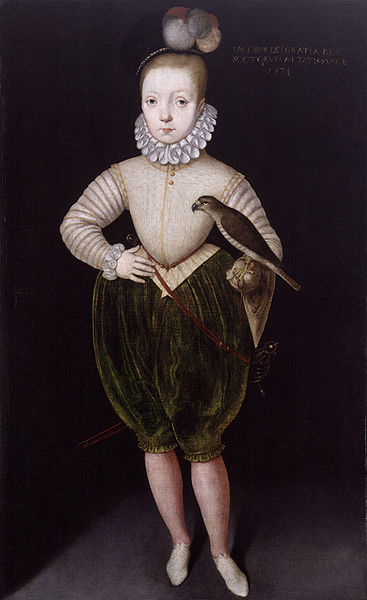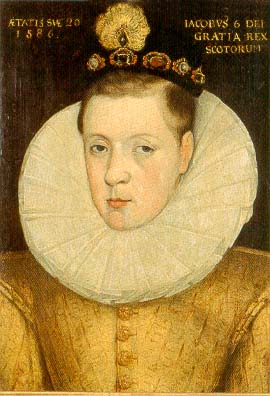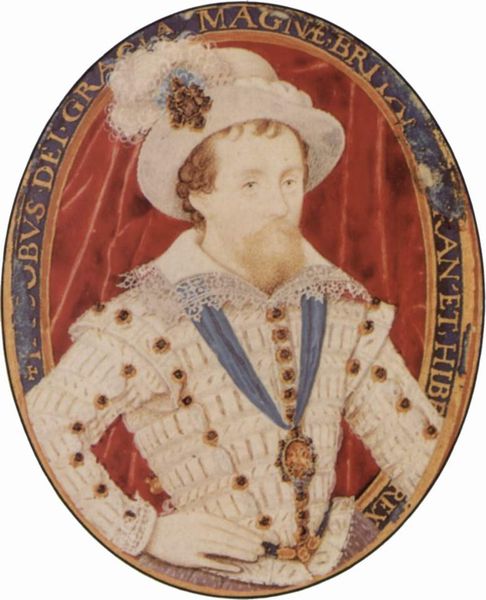<Back to Index>
- Mathematician Joseph Diaz Gergonne, 1771
- Sculptor John Gibson, 1790
- King of Scots and King of England and Ireland James VI and I, 1566
PAGE SPONSOR
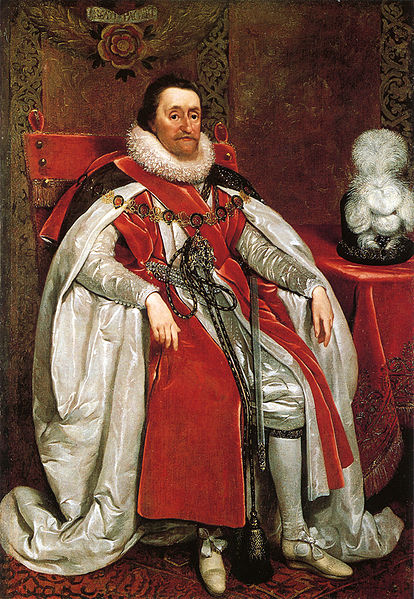
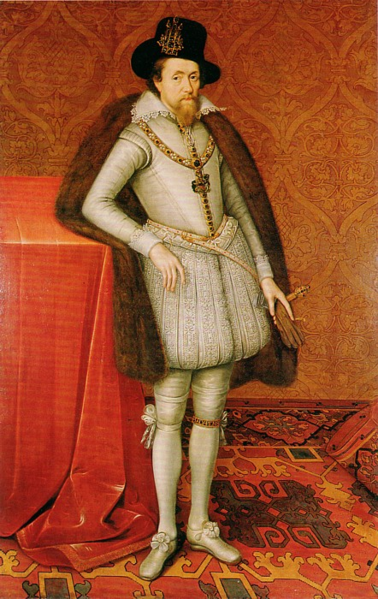
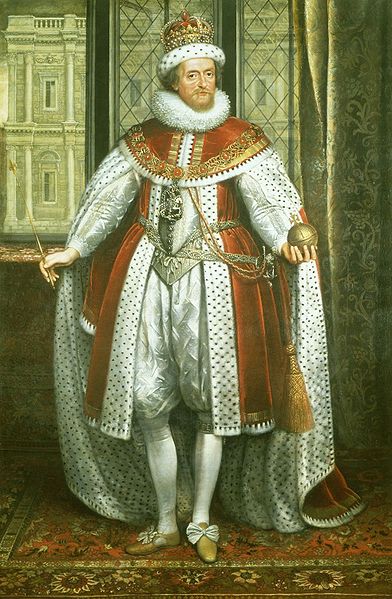
James VI & I (19 June 1566 – 27 March 1625) was King of Scots as James VI from 1567. In 1603, he also became King of England and Ireland as James I when he inherited the English crown and thereby united the Crowns of the Kingdoms of Scotland and England (each country remained legally separate though both ruled by James). James VI & I continued to hold both crowns until his death in 1625, but based himself in England (the larger of the two realms) from 1603. However, he continued to be proud of his Scottish roots & kingdom and to speak the Scots Language.
He became King of Scots as James VI on 24 July 1567, when he was just thirteen months old, succeeding his mother Mary, Queen of Scots, who had been compelled to abdicate in his favour. Four different regents governed during his minority, which ended officially in 1578, though he did not gain full control of his government until 1581. On 24 March 1603, as James I, he succeeded the last Tudor monarch of England and Ireland, Elizabeth I, who died without issue. He
then ruled England, Scotland, and Ireland for 22 years, often using the
title King of Great Britain, until his death at the age of 58. James,
in line with other monarchs of England of the time, also claimed the
title King of France, although he did not actually rule France. Under James, the "Golden Age" of Elizabethan literature and drama continued, with writers such as William Shakespeare, John Donne, Ben Jonson, and Sir Francis Bacon contributing to a flourishing literary culture. James himself was a talented scholar, the author of works such as Daemonologie (1597), True Law of Free Monarchies (1598), and Basilikon Doron (1599). Sir Anthony Weldon claimed that James had been termed "the wisest fool in Christendom", an epithet associated with his character ever since. James's father, Darnley, was murdered on 10 February 1567 during an unexplained explosion at Kirk o' Field, Edinburgh, perhaps in revenge for Rizzio's death. James inherited his father's titles of Duke of Albany and Earl of Ross. Mary was already an unpopular queen, and her marriage on 15 May 1567 to James Hepburn, 4th Earl of Bothwell, who was widely suspected of murdering Darnley, heightened widespread bad feeling towards her. In June 1567, Protestant rebels arrested Mary and imprisoned her in Loch Leven Castle; she never saw her son again. She was forced to abdicate on 24 July in favour of the infant James and to appoint her illegitimate half-brother, James Stewart, Earl of Moray, as regent. The care of James was entrusted to the Earl and Countess of Mar, "to be conserved, nursed, and upbrought" in the security of Stirling Castle. James was crowned King of Scots at the age of thirteen months at the Church of the Holy Rude, Stirling, by Adam Bothwell, Bishop of Orkney, on 29 July 1567. The sermon at the coronation was preached by John Knox. In accordance with the religious beliefs of most of the Scottish ruling class, James was brought up as a member of the Protestant Church of Scotland. The Privy Council selected George Buchanan, Peter Young, Adam Erskine, and David Erskine as James's preceptors or
tutors. As the young king's senior tutor, Buchanan subjected James to
regular beatings but also instilled in him a lifelong passion for
literature and learning. Buchanan sought to turn James into a God-fearing, Protestant king who accepted the limitations of monarchy, as outlined in his treatise De Jure Regni apud Scotos. In 1568 Mary escaped from prison, leading to a brief period of violence. The Earl of Moray defeated Mary's troops at the Battle of Langside, forcing her to flee to England, where she was subsequently imprisoned
by Elizabeth. On 22 January 1570, Moray was assassinated by James Hamilton of Bothwellhaugh, to be succeeded as regent by James's paternal grandfather, Matthew Stewart, 4th Earl of Lennox, who a year later was carried fatally wounded into Stirling Castle after a raid by Mary's supporters. The next regent, John Erskine, 1st Earl of Mar, died soon after banqueting at the estate of James Douglas, 4th Earl of Morton,
where he "took a vehement sickness", dying on 28 October 1572 at
Stirling. Morton, who now took Mar's office, proved in many ways the
most effective of James's regents, but he made enemies by his rapacity. He fell from favour when the Frenchman Esmé Stewart, Sieur d'Aubigny, first cousin of James's father Lord Darnley, and future Earl of Lennox, arrived in Scotland and quickly established himself as the first of James's powerful male favourites. Morton was executed on 2 June 1581, belatedly charged with complicity in Lord Darnley's murder. On 8 August, James made Lennox the only duke in Scotland. Then fifteen years old, the king was to remain under the influence of Lennox for about one more year. Although
a Protestant convert, Lennox was distrusted by Scottish Calvinists, who
noticed the physical displays of affection between favourite and king
and alleged that Lennox "went about to draw the King to carnal lust". In August 1582, in what became known as the Ruthven Raid, the Protestant earls of Gowrie and Angus lured James into Ruthven Castle, imprisoned him, and
forced Lennox to leave Scotland. After James was freed in June 1583, he
assumed increasing control of his kingdom. He pushed through the Black Acts to assert royal authority over the Kirk and between 1584 and 1603 established effective royal government and relative peace among the lords, ably assisted by John Maitland of Thirlestane, who led the government until 1592. One last Scottish attempt against the king's person occurred in August 1600, when James was apparently assaulted by Alexander Ruthven, the Earl of Gowrie's younger brother, at Gowrie House, the seat of the Ruthvens. Since Ruthven was run through by James's page John Ramsay and the Earl of Gowrie was
himself killed in the ensuing fracas, James's account of the
circumstances, given the lack of witnesses and his history with the
Ruthvens, was not universally believed. In 1586, James signed the Treaty of Berwick with
England. That and the execution of his mother in 1587, which he
denounced as a "preposterous and strange procedure", helped clear the
way for his succession south of the border. During the Spanish Armada crisis of 1588, he assured Elizabeth of his support as "your natural son and compatriot of your country", and as time passed and Elizabeth remained unmarried, securing the English succession became a cornerstone of James's policy.
Throughout
his youth, James was praised for his chastity, since he showed little
interest in women; after the loss of Lennox, he continued to prefer
male company. A suitable marriage, however, was necessary to reinforce his monarchy, and the choice fell on the fourteen year old Anne of Denmark, younger daughter of the Protestant Frederick II. Shortly after a proxy marriage in Copenhagen in
August 1589, Anne sailed for Scotland but was forced by storms to the
coast of Norway. On hearing the crossing had been abandoned, James, in
what Willson calls "the one romantic episode of his life", sailed from Leith with a three-hundred strong retinue to fetch Anne personally. The couple were married formally at the Bishop's Palace in Oslo on 23 November and, after stays at Elsinore and Copenhagen,
returned to Scotland in May 1590. By all accounts, James was at first
infatuated with Anne, and in the early years of their marriage seems
always to have showed her patience and affection. The royal couple produced three surviving children: Henry Frederick, Prince of Wales, who died of typhoid fever in 1612, aged 18; Elizabeth, later Queen of Bohemia; and Charles, the future King. Anne died before her husband in March 1619.
James's
visit to Denmark, a country familiar with witch hunts, may have
encouraged an interest in the study of witchcraft, which he considered a branch of theology. He
was delayed from leaving Denmark by bad weather, and was stranded in
Norway for some weeks. After his return to Scotland, he attended the North Berwick witch trials, the first major persecution of witches in Scotland under the Witchcraft Act 1563. Several people, most notably Agnes Sampson,
were convicted of using witchcraft to send storms against James's ship.
James became obsessed with the threat posed by witches and, inspired by
his personal involvement, in 1597 wrote the Daemonologie, a tract which opposed the practice of witchcraft and which provided background material for Shakespeare's Tragedy of Macbeth. James is known to have personally supervised the torture of women accused of being witches. After 1599, his views may have become more sceptical as he wrote to his son, Prince Henry, to congratulate him on "the discovery of yon little counterfeit wench. I pray God ye may be my heir in such discoveries". The forcible dissolution of the Lordship of the Isles by James IV in
1493 had led to troubled times for the western seaboard. Although the
king had the power to subdue the organised military might of the
Hebrides, he and his immediate successors lacked the will or ability to
provide an alternative form of governance. As a result the 16th century
became known as linn nan creach – the time of raids. Furthermore, the effects of the Reformation were slow to impact the Gàidhealtachd, driving a religious wedge between this area and centres of politcal control in the Central Belt. In 1540 James V had conducted a royal tour of the Hebrides, forcing the clan chiefs to accompany him. There followed a period of peace, but all too soon the clans were at loggerheads with one another again. During
James VI's reign the transformation of the 15th century image of the
Hebrides as the cradle of Scottish Christianity and nationhood into one
in which its citizens were regarded as lawless barbarians was complete.
Official documents describe the peoples of the Highlands as "void of
the knawledge and feir of God" who were prone to " all kynd of
barbarous and bestile cruelteis". The Gaelic language,
spoken fluently by James IV and probably by James V, became known in
the time of James VI as "Erse" or Irish, emphasising its foreign
nature. The Scottish Parliament decided it had became a principal cause
of the Highlanders' shortcomings and sought to abolish it. It was against this background that in 1598 James VI authorised the "Gentleman Adventurers of Fife"
to civilise the "most barbarous Isle of Lewis". James wrote that the
colonists were to act "not by agreement" with the local inhabitants,
but "by extirpation of thame". Landing at Stornoway and
initially successful, the colonists were driven out by local forces
commanded by Murdoch and Neil MacLeod. The colonists tried again in
1605 with the same result although a third attempt in 1607 was more
successful. The Statutes of Iona were enacted in 1609, which required that clan chiefs: send their heirs to Lowland Scotland to
be educated in English speaking Protestant schools; provide support for
Protestant ministers to Highland Parishes; outlaw bards; and regularly report to Edinburgh to answer for their actions. So
began a process "specifically aimed at the extirpation of the Gaelic
language, the destruction of its traditional culture and the
suppression of its bearers." James was not averse to making light of his relationship with the Gaels. He visited the town of Nairn in
1589 and is said to have later remarked that the High Street was so
long that the people at either end of the High Street spoke different
languages to one another – English and Gaelic.
In 1597–98, James wrote two works, The True Law of Free Monarchies and Basilikon Doron (Royal Gift), in which he established an ideological base for monarchy. In the True Law, he sets out the divine right of kings,
explaining that for Biblical reasons kings are higher beings than other
men, though "the highest bench is the sliddriest to sit upon". The document proposes an absolutist theory of monarchy, by which a king may impose new laws by royal prerogative but
must also pay heed to tradition and to God, who would "stirre up such
scourges as pleaseth him, for punishment of wicked kings". Basilikon Doron, written as a book of instruction for the four-year-old Prince Henry, provides a more practical guide to kingship. Despite banalities and sanctimonious advice, the work is well written, perhaps the best example of James's prose. James's
advice concerning parliaments, which he understood as merely the king's
"head court", foreshadows his difficulties with the English Commons:
"Hold no Parliaments," he tells Henry, "but for the necesitie of new
Lawes, which would be but seldome". In the True Law James
maintains that the king owns his realm as a feudal lord owns his fief,
because kings arose "before any estates or ranks of men, before any
parliaments were holden, or laws made, and by them was the land
distributed, which at first was wholly theirs. And so it follows of
necessity that kings were the authors and makers of the laws, and not
the laws of the kings." From 1601, in the last years of Elizabeth I's life, certain English politicians, notably her chief minister Sir Robert Cecil, maintained a secret correspondence with James in order to prepare in advance for a smooth succession. In
March 1603, with the Queen clearly dying, Cecil sent James a draft
proclamation of his accession to the English throne. Elizabeth died in
the early hours of 24 March, and James was proclaimed king in London
later the same day. On
5 April, James left Edinburgh for London, promising to return every
three years (a promise he did not keep), and progressed slowly
southwards, to arrive in the capital after Elizabeth's funeral. Local
lords received him with lavish hospitality along the route, and his new
subjects flocked to see him, relieved that the succession had triggered
neither unrest nor invasion. When he entered London on 7 May, he was mobbed by a crowd of spectators. His English coronation took place on 25 July, with elaborate allegories provided by dramatic poets such as Thomas Dekker and Ben Jonson. Even though an outbreak of plague restricted festivities, "the
streets seemed paved with men," wrote Dekker. "Stalls instead of rich
wares were set out with children, open casements filled up with women". The
kingdom to which James succeeded was, however, not without its
problems. Monopolies and taxation had engendered a widespread sense of
grievance, and the costs of war in Ireland had become a heavy burden on the government. Despite
the smoothness of the succession and the warmth of his welcome, James
survived two conspiracies in the first year of his reign, the Bye Plot and Main Plot, which led to the arrest, among others, of Lord Cobham and Sir Walter Raleigh. Those hoping for governmental change from James were at first disappointed when he maintained Elizabeth's Privy Councillors in office, as secretly planned with Cecil, but James shortly added long-time supporter Henry Howard and his nephew Thomas Howard to the Privy Council, as well as five Scottish nobles. In
the early years of James's reign, the day-to-day running of the
government was tightly managed by the shrewd Robert Cecil, later Earl of Salisbury, ably assisted by the experienced Thomas Egerton, whom James made Baron Ellesmere and Lord Chancellor, and by Thomas Sackville, soon Earl of Dorset, who continued as Lord Treasurer. As
a consequence, James was free to concentrate on bigger issues, such as
a scheme for a closer union between England and Scotland and matters of
foreign policy, as well as to enjoy his leisure pursuits, particularly
hunting. James was ambitious to build on the personal union of the Crowns of Scotland and England to establish a single country under one monarch, one parliament and one law, a plan which met opposition in both realms. "Hath
He not made us all in one island," James told the English parliament,
"compassed with one sea and of itself by nature indivisible?" In April
1604, however, the Commons refused on legal grounds his request to be
titled "King of Great Britain". In October 1604, he assumed the title "King of Great Britain" by proclamation rather than statute, though Sir Francis Bacon told him he could not use the style in "any legal proceeding, instrument or assurance". In foreign policy, James achieved more success. Never having been at war with Spain, he devoted his efforts to bringing the long Anglo–Spanish War to an end, and in August 1604, thanks to skilled diplomacy on the part of Robert Cecil and Henry Howard, now Earl of Northampton, a peace treaty was signed between the two countries, which James celebrated by hosting a great banquet. Freedom
of worship for Catholics in England continued, however, to be a major
objective of Spanish policy, causing constant dilemmas for James,
distrusted abroad for repression of Catholics while at home being
encouraged by the Privy Council to show even less tolerance towards
them.
Under James, expansion of English international trade and influence was actively pursued through the East India Company. An English settlement was already established in Bantam, on the island of Java, and in 1613, following an invitation from the English adventurer William Adams in Japan, the English captain John Saris arrived at Hirado in the ship Clove with the intent of establishing a trading factory. Adams and Saris travelled to Shizuoka where they met with Tokugawa Ieyasu at his principal residence in September before moving on to Edo where they met Ieyasu's son Hidetada. During that meeting, Hidetada gave Saris two varnished suits of armour for James, today housed in the Tower of London. On their way back, they visited Tokugawa once more, who conferred trading privileges on the English through a Red Seal permit giving them "free license to abide, buy, sell and barter" in Japan. The
English party headed back to Hirado on 9 October 1613. However, during
the ten year activity of the company between 1613 and 1623, apart from
the first ship (Clove in 1613), only three other English ships brought cargoes directly from London to Japan.
On 5 November 1605, the eve of the state opening of the second session of James's first English Parliament, a soldier named Guy Fawkes was
discovered in the cellars of the parliament buildings. He was guarding
a pile of wood not far from 36 barrels of gunpowder with which Fawkes
intended to blow up Parliament House the following day and cause the
destruction, as James put it, "not only ... of my person, nor of
my wife and posterity also, but of the whole body of the State in
general". The sensational discovery of the Catholic Gunpowder Plot,
as it quickly became known, aroused a mood of national relief at the
delivery of the king and his sons which Salisbury exploited to extract
higher subsidies from the ensuing Parliament than any but one granted
to Elizabeth. The
co-operation between monarch and Parliament following the Gunpowder
plot was atypical. Instead, it was the previous session of 1604 that
shaped the attitudes of both sides for the rest of the reign, though
the initial difficulties owed more to mutual incomprehension than
conscious enmity. On 7 July 1604, James had angrily prorogued Parliament
after failing to win its support either for full union or financial
subsidies. "I will not thank where I feel no thanks due," he had
remarked in his closing speech. "... I am not of such a stock as
to praise fools ... You see how many things you did not
well ... I wish you would make use of your liberty with more
modesty in time to come". As James's reign progressed, his government faced growing financial pressures, due partly to creeping inflation but
also to the profligacy and financial incompetence of James's court. In
February 1610 Salisbury, a believer in parliamentary participation in
government, proposed a scheme, known as the Great Contract,
whereby Parliament, in return for ten royal concessions, would grant a
lump sum of £600,000 to pay off the king's debts plus an annual
grant of £200,000. The
ensuing prickly negotiations became so protracted that James eventually
lost patience and dismissed Parliament on 31 December 1610. "Your
greatest error," he told Salisbury, "hath been that ye ever expected to
draw honey out of gall". The same pattern was repeated with the so-called "Addled Parliament" of 1614, which James dissolved after a mere eight weeks when Commons hesitated to grant him the money he required. James then ruled without parliament until 1621, employing officials such as the businessman Lionel Cranfield,
who were astute at raising and saving money for the crown, and sold
earldoms and other dignities, many created for the purpose, as an
alternative source of income. Another potential source of income was the prospect of a Spanish dowry from a marriage between Charles, Prince of Wales, and the Spanish Infanta, Maria. The policy of the Spanish Match, as it was called, was also attractive to James as a way to maintain peace with Spain and avoid the additional costs of a war. Peace
could be maintained as effectively by keeping the negotiations alive as
by consummating the match — which may explain why James protracted the
negotiations for almost a decade.
The
policy was supported by the Howards and other Catholic-leaning
ministers and diplomats — together known as the Spanish Party — but
deeply distrusted in Protestant England. James's policy was further
jeopardised by the outbreak of the Thirty Years' War, especially after his son-in-law, Frederick V, Elector Palatine, was ousted from Bohemia by Emperor Ferdinand II in 1620, and Spanish troops simultaneously invaded Frederick's Rhineland home
territory. Matters came to a head when James finally called a
parliament in 1621 to fund a military expedition in support of his
son-in-law. The Commons on the one hand granted subsidies inadequate to finance serious military operations in aid of Frederick, and
on the other — remembering the profits gained under Elizabeth by naval
attacks on Spanish gold shipments — called for a war directly against
Spain. In November 1621, led by Sir Edward Coke,
they framed a petition asking not only for war with Spain but also for
Prince Charles to marry a Protestant, and for enforcement of the
anti-Catholic laws. James flatly told them not to interfere in matters of royal prerogative or they would risk punishment, which provoked them into issuing a statement protesting their rights, including freedom of speech. Urged on by the Duke of Buckingham and the Spanish ambassador Gondomar, James ripped the protest out of the record book and dissolved Parliament. In 1623, Prince Charles, now 23, and Buckingham decided to seize the initiative and travel to Spain incognito, to win the Infanta directly, but the mission proved a desperate mistake. The
Infanta detested Charles, and the Spanish confronted them with terms
that included his conversion to Catholicism and a one-year stay in
Spain as, in essence, a diplomatic hostage. Though a treaty was signed,
the prince and duke returned to England in October without the Infanta
and immediately renounced the treaty, much to the delight of the
British people. Their
eyes opened by the visit to Spain, Charles and Buckingham now turned
James's Spanish policy upon its head and called for a French match and
a war against the Habsburg empire. To
raise the necessary finance, they prevailed upon James to call another
Parliament, which met in February 1624. For once, the outpouring of
anti-Catholic sentiment in the Commons was echoed in court, where
control of policy was shifting from James to Charles and Buckingham, who pressured the king to declare war and engineered the impeachment of Lord Treasurer Lionel Cranfield, by now made Earl of Middlesex, when he opposed the plan on grounds of cost. The
outcome of the Parliament of 1624 was ambiguous: James still refused to
declare war, but Charles believed the Commons had committed themselves
to finance a war against Spain, a stance which was to contribute to his
problems with Parliament in his own reign. After the Gunpowder Plot, James sanctioned harsh measures for controlling non-conforming English Catholics. In May 1606, Parliament passed the Popish Recusants Act which could require any citizen to take an Oath of Allegiance denying the Pope's authority over the king. James was conciliatory towards Catholics who took the Oath of Allegiance, and tolerated crypto Catholicism even at court. Towards the Puritan clergy, with whom he debated at the Hampton Court Conference of 1604, James was at first strict in enforcing conformity, inducing a sense of persecution amongst many Puritans; but
ejections and suspensions from livings became fewer as the reign wore
on. As a result of the Hampton Court Conference a new translation and
compilation of approved books of the Bible was commissioned to resolve issues with translations then being used. The Authorised King James Version, as it came to be known, was completed in 1611 and is considered a masterpiece of Jacobean prose. It is still in widespread use. In Scotland, James attempted to bring the Scottish kirk "so neir as can be" to the English church and to reestablish episcopacy, a policy which met with strong opposition. In 1618, James's bishops forced his Five Articles of Perth through a General Assembly; but the rulings were widely resisted. James was to leave the church in Scotland divided at his death, a source of future problems for his son.
Throughout
his life James had close relationships with male courtiers, which has
caused debate among historians about their nature. After
his accession in England, his peaceful and scholarly attitude
strikingly contrasted with the bellicose and flirtatious behaviour of
Elizabeth, as indicated by the contemporary epigram Rex fuit Elizabeth, nunc est regina Jacobus (Elizabeth was King, now James is Queen). Some of James's biographers conclude that Esmé Stewart (later Duke of Lennox), Robert Carr (later Earl of Somerset), and George Villiers (later Duke of Buckingham) were his lovers. Restoration of Apethorpe Hall, undertaken in 2004 – 2008, revealed a previously unknown passage linking the bedchambers of James and Villiers. Others argue that the relationships were not sexual. In Basilikon Doron James
lists sodomy among crimes "ye are bound in conscience never to
forgive", and James's wife Anne gave birth to seven live children, as
well as suffering two stillbirths and at least three other miscarriages. When the Earl of Salisbury died in 1612, he was little mourned by those who jostled to fill the power vacuum. Until
Salisbury's death, the Elizabethan administrative system over which he
had presided continued to function with relative efficiency; from this
time forward, however, James's government entered a period of decline
and disrepute. Salisbury's
passing gave James the notion of governing in person as his own chief
Minister of State, with his young Scottish favourite, Robert Carr, Viscount Rochester,
carrying out many of Salisbury's former duties, but James's inability
to attend closely to official business exposed the government to
factionalism. The Howard party, consisting of Northampton, Suffolk, Suffolk's son-in-law Lord Knollys, and Charles Howard, Earl of Nottingham,
along with Sir Thomas Lake, soon took control of much of the government
and its patronage. Even the powerful Carr, hardly experienced for the
responsibilities thrust upon him and often dependent on his intimate
friend Sir Thomas Overbury for assistance with government papers, fell into the Howard camp, after beginning an affair with the married Frances Howard, Countess of Essex, daughter of the Earl of Suffolk, whom James assisted in securing an annulment of her marriage to free her to marry Carr. In
summer 1615, however, it emerged that Overbury, who on 15 September
1613 had died in the Tower of London, where he had been placed at the
King's request, had been poisoned. Among
those convicted of the murder were Frances Howard and Robert Carr, the
latter having been replaced as the king's favourite in the meantime by
Villiers. The implication of the King in such a scandal provoked much
public and literary conjecture and irreparably tarnished James's court
with an image of corruption and depravity. The subsequent downfall of the Howards left Villiers unchallenged as the supreme figure in the government by 1618.
During
the last year of James's life, with Buckingham consolidating his
control of Charles to ensure his own future, the king was often
seriously ill, leaving him an increasingly peripheral figure, rarely
able to visit London. In early 1625, James was plagued by severe attacks of arthritis, gout and fainting fits, and in March fell seriously ill with tertian ague and then suffered a stroke. James finally died at Theobalds House on 27 March during a violent attack of dysentery, with Buckingham at his bedside. James's funeral, a magnificent but disorderly affair, took place on 7 May. Bishop John Williams of Lincoln preached the sermon, observing, "King Solomon died in Peace, when he had lived about sixty years ... and so you know did King James". The
king was widely mourned. For all his flaws, James had never completely
lost the affection of his people, who had enjoyed uninterrupted peace
and comparatively low taxation during the Jacobean era. "As he lived in peace," remarked the Earl of Kellie, "so did he die in peace, and I pray God our king [Charles I] may follow him". The earl prayed in vain: once in power, Charles and Buckingham sanctioned a series of reckless military expeditions that ended in humiliating failure. James bequeathed Charles a fatal belief in the divine right of kings, combined with a disdain for Parliament, which culminated in the English Civil War and
the execution of Charles. James had often neglected the business of
government for leisure pastimes, such as the hunt; and his later
dependence on male favourites at a scandal-ridden court undermined the
respected image of monarchy so carefully constructed by Elizabeth. The
stability of James's government in Scotland, however, and in the early
part of his English reign, as well as his relatively enlightened views
on religious issues and war, have earned him a re-evaluation from many
recent historians, who have rescued his reputation from a tradition of
criticism stemming back to the anti-Stuart historians of the mid seventeenth century. Under James the Plantation of Ulster by English and Scots Protestants began, and the English colonisation of North America started its course. In 1607, Jamestown was founded in Virginia, and in 1610 Cuper's Cove in Newfoundland.
During the next 150 years, England would fight with Spain, the
Netherlands, and France for control of the continent, while religious
division in Ireland between Protestant and Catholic has lasted for 400
years.
James was the only son of Mary, Queen of Scots, and her second husband, Henry Stuart, Lord Darnley. Both Mary and Darnley were great-grandchildren of Henry VII of England through Margaret Tudor, the older sister of Henry VIII. Mary's rule over Scotland was insecure, for both she and her husband, being Roman Catholics, faced a rebellion by Protestant noblemen. During Mary's and Darnley's difficult marriage, Darnley secretly allied himself with the rebels and conspired in the murder of the Queen's private secretary, David Rizzio, just three months before James was born. James was born on 19 June 1566 at Edinburgh Castle, and as the eldest son and heir apparent of the monarch automatically became Duke of Rothesay and Prince and Great Steward of Scotland. He was baptised "Charles James" on 17 December 1566 in a Catholic ceremony held at Stirling Castle. His godparents were Charles IX of France (represented by John, Count of Brienne), Elizabeth I of England (represented by James's aunt, Jean, Countess of Argyll), and Emmanuel Philibert, Duke of Savoy (represented by Philibert du Croc, the French ambassador). Mary refused to let the Archbishop of St Andrews, whom she referred to as "a pocky priest", spit in the child's mouth, as was then the custom.
James was concerned in the 1580s and 1590s to promote the literature of the country of his birth. His treatise, Some Rules and Cautions to be Observed and Eschewed in Scottish Prosody, published in 1584 at the age of 19, was both a poetic manual and a description of the poetic tradition in his mother tongue, Scots, applying Renaissance principles. He also made statutory provision to reform and promote the teaching of music, seeing the two in connection. In furtherance of these aims he was both patron and head of a loose circle of Scottish Jacobean court poets and musicians, the Castalian Band, which included among others William Fowler and Alexander Montgomerie, the latter being a favourite of the King. James, himself a poet, was happy to be seen as a practising member in the group. By
the late 1590s his championing of his native Scottish tradition was to
some extent diffused by the increasingly expected prospect of
inheritance of the English throne, and some courtier poets who followed the king to London after 1603, such as William Alexander, were starting to anglicise their written language. James's
characteristic role as active literary participant and patron in the
Scottish court made him in many respects a defining figure for English
Jacobean poetry and drama, which would reach a pinnacle of achievement
in his reign, but his patronage for the high style in his own Scottish tradition, a tradition which includes his ancestor James I of Scotland, largely became sidelined.
